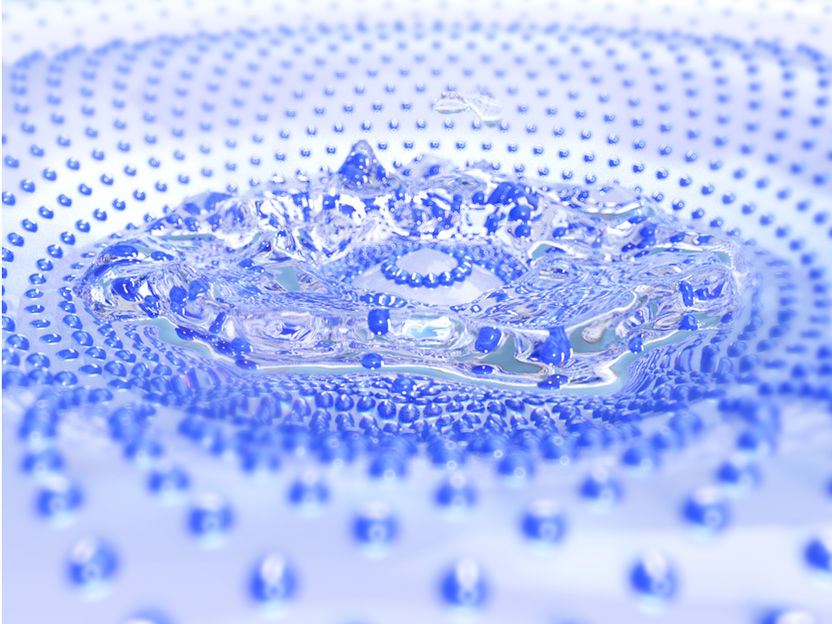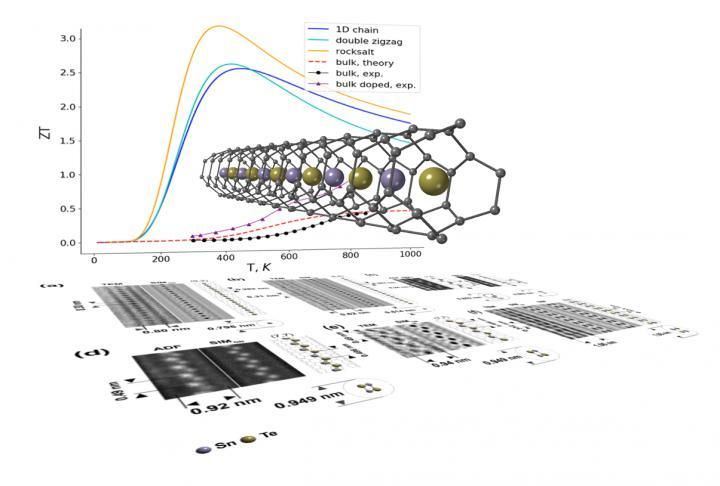First glimpse of hydrodynamic electron flow in 3D materials
"Really to "see" electrons flowing through a thin piece of metal like water through a pipe is very exciting"
electrons flow through most materials more like a gas than a fluid, meaning they don’t interact much with one another. It was long hypothesized that electrons could flow like a fluid, but only recent advances in materials and measurement techniques allowed these effects to be observed in 2D materials. In 2020, first groups image electrons flowing in graphene like water flows through a pipe.

Electrons flow like water
© MPI CPfS (C. Pouss)
Recent research suggested that hydrodynamic electron flow in 3D conductors was possible, but exactly how it happened or how to observe it remained unknown. Until now.
A team of researchers from Harvard, MIT and the Max Planck Institute Chemical Physics of Solids developed a theory to explain how hydrodynamic electron flow could occur in 3D materials and observed it for the first time using a new imaging technique.
Electrons flow through most materials more like a gas than a fluid, meaning they don’t interact much with one another. It was long hypothesized that electrons could flow like a fluid, but only recent advances in materials and measurement techniques allowed these effects to be observed in 2D materials. In 2020, the labs of Amir Yacoby, Professor of Physics and of Applied Physics at the Harvard John A. Paulson School of Engineering and Applied Sciences (SEAS), Philip Kim, Professor of Physics and Professor Applied Physics at Harvard and Ronald Walsworth, formerly of the Department of Physics at Harvard, were among the first to image electrons flowing in graphene like water flows through a pipe.
The findings provided a new sandbox in which to explore electron interactions and offered a new way to control electrons — but only in two-dimensional materials. Electron hydrodynamics in three-dimensional materials remained much more elusive because of a fundamental behavior of electrons in conductors known as screening. When there is a high density of electrons in a material, as in conducting metals, electrons are less inclined to interact with one another.
Recent research suggested that hydrodynamic electron flow in 3D conductors was possible, but exactly how it happened or how to observe it remained unknown. Until now. A team of researchers from Harvard, MIT and the Max Planck Institute Chemical Physics of Solids developed a theory to explain how hydrodynamic electron flow could
“This research provides a promising avenue for the search for hydrodynamic flow and prominent electron interactions in high-carrier-density materials,” said Prineha Narang, Assistant Professor of Computational Materials Science at SEAS and a senior author of the study.
Hydrodynamic electron flow relies on strong interactions between electrons, just as water and other fluids rely on strong interactions between their particles. In order to flow efficiently, electrons in high density materials arrange themselves in such a way that limits interactions. It’s the same reason that group dances like the electric slide don’t involve a lot of interaction between dancers — with that many people, it's easier for everyone to do their own moves.
“To date, hydrodynamic effects have mostly been deduced from transport measurements, which effectively jumbles up the spatial signatures,” said Yacoby. “Our work has charted a different path in observing this dance and understanding hydrodynamics in systems beyond graphene with new quantum probes of electron correlations.”
The researchers proposed that rather than direct interactions, electrons in high density materials could interact with one another through the quantum vibrations of the atomic lattice, known as phonons.
“We can think of the phonon-mediated interactions between electrons by imagining two people jumping on a trampoline, who don’t propel each other directly but rather via the elastic force of the springs,” said Yaxian Wang, a postdoctoral scholar in the NarangLab at SEAS and co-author of the study.
In order to observe this mechanism, the researchers developed a new cryogenic scanning probe based on the nitrogen-vacancy defect in diamond, which imaged the local magnetic field of a current flow in a material called layered semimetal tungsten ditelluride. “Our tiny quantum sensor is sensitive to small changes in the local magnetic field, allowing us to explore the magnetic structure in a material directly,” said Uri Vool, John Harvard distinguished science fellow and the first author of the study.
Johannes Gooth, a co-author of the study, is extremely excited about the study and he is looking forward to see more of the potential hydrodynamic materials being investigated with this technique. "Really to "see" electrons flowing through a thin piece of metal like water through a pipe is very exciting. When we started planning the experiments 4 years ago, that was completely unclear. The mechanism behind the hydrodynamic electron flow is very general and turns our general understanding of metals upside down once again. "
Not only did the researchers find evidence of hydrodynamic flow within three-dimensional tungsten ditelluride but they also found that the hydrodynamic character of the current strongly depends on the temperature. “Hydrodynamic flow occurs in a narrow regime where temperature is not too high and not too low, and so the unique ability to scan across a wide temperature range was crucial to see the effect,” said Assaf Hamo, a postdoctoral scholar at the Yacoby lab and co-lead author of the study.
“The ability to image and engineer these hydrodynamic flows in three-dimensional conductors as a function of temperature, opens up the possibility to achieve near dissipation-less electronics in nanoscale devices, as well as provides new insights into understanding electron-electron interactions,” said Georgios Varnavides, a Ph.D student in the NarangLab at SEAS and one of the lead authors of the study. ”The research also paves the way for exploring non-classical fluid behavior in hydrodynamic electron flow, such as steady-state vortices.”
“This is an exciting and interdisciplinary field synthesizing concepts from condensed matter and materials science to computational hydrodynamics and statistical physics,” said Narang. In previous research, Varnavides and Narang classified different types of hydrodynamic behaviors which could arise in quantum materials where electrons flow collectively.
Original publication
Uri Vool, Assaf Hamo, Georgios Varnavides, Yaxian Wang, Tony X. Zhou, Nitesh Kumar, Yuliya Dovzhenko, Ziwei Qiu, Christina A. C. Garcia, Andrew T. Pierce, Johannes Gooth, Polina Anikeeva, Claudia Felser, Prineha Narang, and Amir Yacoby; "Imaging phonon-mediated hydrodynamic flow in WTe2"; Nature Physics; 2021





























































